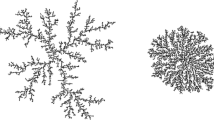Abstract
Aggregation of mass by perfectly inelastic collisions in a one-dimensional gas of point particles is studied. The dynamics is governed by laws of mass and momentum conservation. The motion between collisions is free. An exact probabilistic description of the state of the aggregating gas is presented. For an initial configuration of equidistant particles on the line with Maxwellian velocity distribution, the following results are obtained in the long-time limit. The probability for finding empty intervals of length growing faster thant 2/3 vanishes. The mass spectrum can range from the initial mass up to mass of ordert 2/3. Aggregates with masses growing faster thant 2/3 cannot occur. Our estimates are in accordance with numerical simulations predictingt −1 decay for the number density of initial masses and a slowert −2/3 decay for the density of aggregates resulting from a large number of collisions (with masses ∼t 2/3). Our proofs rely on a link between the considered aggregation dynamics and Brownian motion in the presence of absorbing barriers.
Similar content being viewed by others
References
G. F. Carnevale, Y. Pomeau, and W. R. Young,Phys. Rev. Lett. 64:2913 (1990).
Y. Jiang and F. Leyvraz, Scaling theory for ballistic aggregation, preprint, Instituto de Fisica, Laboratorio de Cuernavaca, Mexico.
P.-A. Rey, Etude de modèles d'agrégation balistique par simulations numériques, Institute for Theoretical Physics, University of Geneva (1993).
J. Piasecki,Physica A 190:95 (1992)
S. Chandrasekar,Rev. Mod. Phys. 15:1 (1943) [Reprinted inSelected Papers on Noise and Stochastic Processes, N. Wax, ed., (Dover, New York, 1954).
M. H. Ernst, Kinetics of clustering in irreversible aggregation,inFractals in Physics, L. Pietronero and E. Tusatti, eds. (North-Holland, Amsterdam, 1986, p. 289); see also P. G. J. van Dongen and M. H. Ernst,J. Stat. Phys. 50:795 (1988).
B. Derrida, C. Godrèche, and I. Yekutieli,Europhys. Lett. 12:385 (1990);Phys. Rev. A 44:6241 (1991); K. Pesz and G. J. Rodgers,J. Phys. A: Math. Gen. 25:705 (1992).
D. Ruelle,Statistical Mechanics: Rigorous Results (Benjamin, 1969), Chapter 7.
B. Simon,Functional Integration and Quantum Physics (Academic Press, 1979, Sections 7 and 21).
S. Flügge,Practical Quantum Mechanics (Springer, 1972).
Author information
Authors and Affiliations
Rights and permissions
About this article
Cite this article
Martin, P.A., Piasecki, J. One-dimensional ballistic aggregation: Rigorous long-time estimates. J Stat Phys 76, 447–476 (1994). https://doi.org/10.1007/BF02188670
Received:
Accepted:
Issue Date:
DOI: https://doi.org/10.1007/BF02188670




